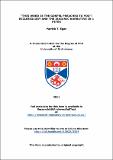Files in this item
"This word is the gospel preached to you" : ecclesiology and the Isaianic narrative in 1 Peter
Item metadata
| dc.contributor.advisor | Bauckham, Richard | |
| dc.contributor.advisor | Macaskill, Grant | |
| dc.contributor.author | Egan, Patrick T. | |
| dc.coverage.spatial | xii, 194 | en_US |
| dc.date.accessioned | 2013-06-03T15:18:51Z | |
| dc.date.available | 2013-06-03T15:18:51Z | |
| dc.date.issued | 2011 | |
| dc.identifier | uk.bl.ethos.574499 | |
| dc.identifier.uri | https://hdl.handle.net/10023/3594 | |
| dc.description.abstract | The appropriation of Isaiah in 1 Peter occurs through explicit quotations, but also by means of subtle allusions and echoes. I propose that the ecclesiology of 1 Peter draws upon the narrative of the restoration of divine presence among the people of God despite present suffering, which is informed largely by the themes and images of Isaiah, so that the church is identified as participants in a scriptural narrative through its participation in Christ, who is understood to be the Messiah of the scriptures. This study explores the relationship between 1 Peter and the scriptures it employs along several lines. First, comparison is made with available textual evidence to determine differences between the texts in 1 Peter and their Vorlagen. This helps determine the extent to which texts have been modified, the cause of modification, and any interpretive uses such modifications may have occurred. Second, individual texts used in 1 Peter are correlated with the larger narrative of scripture. It is argued that the terms suffering and glory express this narrative in the language of the epistle as a present conflict and future resolution. Third, Isaiah informs the ecclesiology of the letter, in harmony with other scriptural texts, so that the church is viewed as participating in the scriptural narrative of the restoration of divine presence. Finally, the narrative drawn from scripture provides comfort and consolation to Christians suffering in Asia Minor by showing how present suffering is consistent with the experiences of God’s people in ages past and with the experience of Christ. Furthermore, the hope of future glory entails the vindication of present calamities and the reward of honorable conduct. I conclude by showing how the Isaianic narrative has been formative for Peter’s understanding of the church. In his address to the churches of Asia Minor, he builds an argument from his reading of the Isaianic narrative that 1) indicates how the scriptures of Israel are the basis of gospel proclamation and community formation, 2) proposes a high ethical standard in the midst of suffering based on the pattern of Christ, and 3) depicts the vindication of the suffering church at the revelation of Christ. | en_US |
| dc.language.iso | en | en_US |
| dc.publisher | University of St Andrews | |
| dc.subject.lcc | BS2795.52E4 | |
| dc.subject.lcsh | Bible. N.T. Peter, 1st--Criticism, interpretation, etc. | en_US |
| dc.subject.lcsh | Bible. N.T. Peter, 1st--Relation to Isaiah | en_US |
| dc.subject.lcsh | Church history--Early church, ca. 30-600 | en_US |
| dc.subject.lcsh | Communities--Religious aspects--Christianity | en_US |
| dc.subject.lcsh | Suffering in the Bible | en_US |
| dc.title | "This word is the gospel preached to you" : ecclesiology and the Isaianic narrative in 1 Peter | en_US |
| dc.type | Thesis | en_US |
| dc.contributor.sponsor | Ministry and Education Foundation | en_US |
| dc.type.qualificationlevel | Doctoral | en_US |
| dc.type.qualificationname | PhD Doctor of Philosophy | en_US |
| dc.publisher.institution | The University of St Andrews | en_US |
This item appears in the following Collection(s)
Items in the St Andrews Research Repository are protected by copyright, with all rights reserved, unless otherwise indicated.

